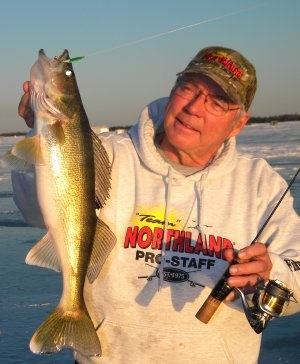 Recently I traveled to Red Lake for a couple days of ice fishing with good friend Duane Peterson. Duane is a “fish-head” from Bemidji who spends lots of time on the water and ice. Our two days together reinforced our common belief that lures fished in a jigging or moving fashion often out-produce baits suspended beneath bobbers.
Recently I traveled to Red Lake for a couple days of ice fishing with good friend Duane Peterson. Duane is a “fish-head” from Bemidji who spends lots of time on the water and ice. Our two days together reinforced our common belief that lures fished in a jigging or moving fashion often out-produce baits suspended beneath bobbers.

While our thoughts regarding moving baits were reinforced, we also learned an important twist regarding how to enhance that movement.
We enjoyed two outstanding days catching walleyes. Targeting the 10-12 foot depth s, we were able to catch several dozen fish. We each started fishing two lines, one a “set line” with a minnow suspended beneath a bobber and the other a jigging lure. The jigging baits out-fished the set lines by at least two to one. The jigs were so much better, in fact, that the second day we abandoned the set lines.
Macho Minnow jigging spoons proved to be our best fish producers. What was most prevalent, however, was the fact that baits fished on no-stretch superline as opposed to monofilament line produced the most fish.
Duane had his jigging rods spooled with Bionic Ice Braid superline with a short Bionic Ice Fluorosilk leader tied in between the braid and the spoon. Fluorosilk adds a bit of shock resistance on the hook set and also is nearly invisible to the fish. My rigs consisted of monofilament line entirely.
Over the two days, Duane caught more fish. My fishing buddies would say that is because he is a better angler. That may be true, what we surmised, however, after much trial and error using different spoons and lures is that those fished on the braid out-produced lures fished on monofilament. In fact, when I switched to braid I had more bites and caught more fish than when fishing monofilament.
Why the braid produced more fish is open for debate. The walleyes we caught definitely showed a preference for aggressive jigging motions. Duane and I believed that the lures on braids produced fish better because the low stretch properties of the line made the baits fish with more erratic and violent movements; keying in on the aggressive behavior shown by these walleyes.
Late in the second day, when the action slowed a bit, Duane tied on a Live-Forage Rippin’ Shad. This is a lipless rattle bait like those often used for open water cast and retrieve fishing. Recently, however, these aggressive baits have been gaining much notoriety as ice jigging lures as well. Duane’s switch quickly put four additional walleyes on the ice, once again proving these walleyes preference for action. I also switched to a Rippin’ Shad, but only caught a couple small fish on it. Interestingly, my shad was tied on monofilament again. Had we had more time, I would have converted to superline for that set up as well.
This trip reinforced the fact that aggressive, moving lures often out-produce more stationary baits under the ice. The real lesson, however, is in how fishing line can affect lure action and ultimately fishing success. Bionic Ice Braid will, in fact, have a more prominent place in my winter fishing arsenal, especially when fish show a real preference for aggression. As always, good luck on the ice!

